30 Smart Light Bulbs Compared
I’ve reviewed a lot of smart light bulbs, but finding the very best is a whole new challenge.
You may have seen my latest video here, where I summarized the best smart bulbs and also mentioned some runner-ups. In that video, I explained how I discovered the winners: by rating each bulb in 10 different categories.
In this article, I will share my ratings in a few comparison tables, and also summarize the pros and cons of each smart bulb.
I categorized the bulbs to make it easier to compare. Feel free to jump around using the table of contents.
(Also you may want to check out this article after, which has another comparison table showing some of these bulbs’ lumens, Kelvins, price range, etc.)
Now let’s dive in!
Inexpensive WiFi bulbs
Affiliate Disclosure: This page has affiliate links, which earn us commission at no cost to you.
Here are my ratings for the inexpensive WiFi bulbs. Please note that you can scroll the table horizontally to see more. →
| rated 1 to 5, 5 is best | Bright or Kelvin | White Accuracy | RGB Saturation | Compatibile | Reliable | Acces- sories | Value | App | Special Features | Power On State | Overall Rating | |
|---|---|---|---|---|---|---|---|---|---|---|---|---|
| WiZ 60w A19 | 4 | 5 | 3 | 4 | 4 | 3 | 5 | 2 | 0 | 5 | 35 | WiZ 60w A19 |
| TECKIN | 4 | 4 | 1 | 4 | 4 | 0 | 5 | 3 | 0 | 0 | 25 | TECKIN |
| Wyze Bulb (white) | 4 | 5 | 0 | 2 | 4 | 2 | 4 | 3 | 0 | 5 | 29 | Wyze Bulb (white) |
| TP-Link Kasa KL130 | 4 | 5 | 4 | 4 | 4 | 2 | 4 | 3 | 1 | 1 | 32 | TP-Link Kasa KL130 |
| TP-Link Kasa KL125 | 3 | 5 | 4 | 4 | 4 | 2 | 4 | 3 | 1 | 1 | 31 | TP-Link Kasa KL125 |
| Cree Connected Max A21 | 5 | 5 | 3 | 3 | 4 | 0 | 5 | 3 | 0 | 0 | 28 | Cree Connected Max A21 |
| Govee RGBWW | 4 | 5 | 3 | 2 | 4 | 0 | 5 | 3 | 2 | 0 | 28 | Govee RGBWW |
WiZ 60w A19 🏆
Winner: Best Inexpensive WiFi Bulb Overall
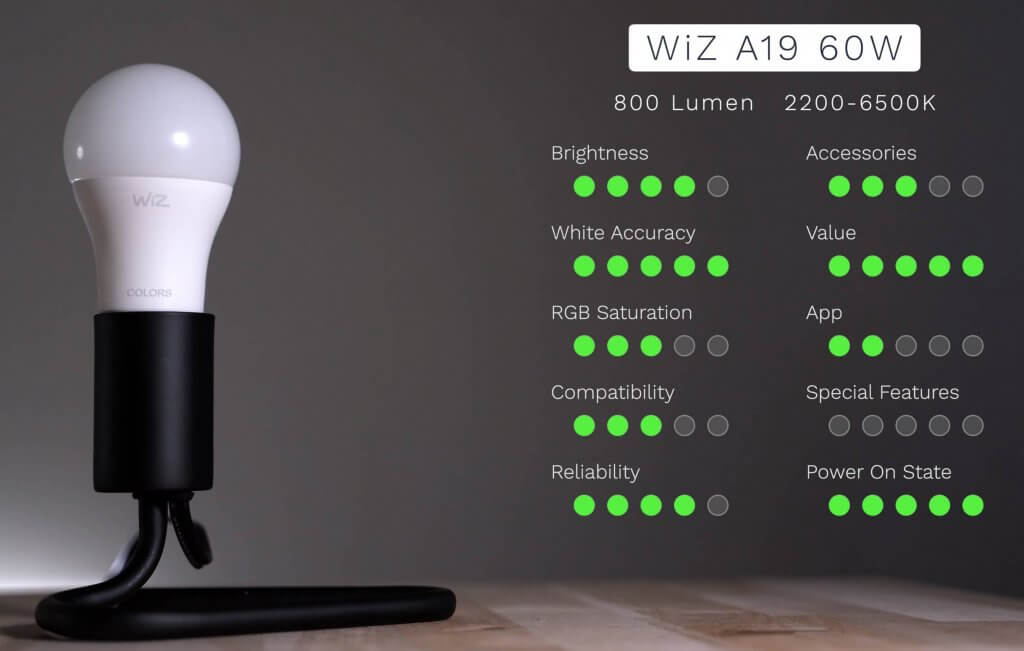
✓ Power On State. If you are having any smart light bulbs in bedrooms, then this is a must-have so it doesn’t wake anyone up during a power outage.
✓ Great white and RGB colors.
✓ Brightness was above average for this price. It was slightly less bright on the warm white but it wasn’t very noticeable. Anything above 4500K was max brightness so that’s great.
✓ WiZ makes a WiZmote and motion sensors for controlling their lights. If you connect WiZ to SmartThings then you have even more accessories to connect to.
✓ Minimum brightness was good in that it could get dim at 1% brightness.
✘ The WiZ app could be better. The bulbs aren’t labeled in the app so selecting a light to change is a guessing game.
TECKIN
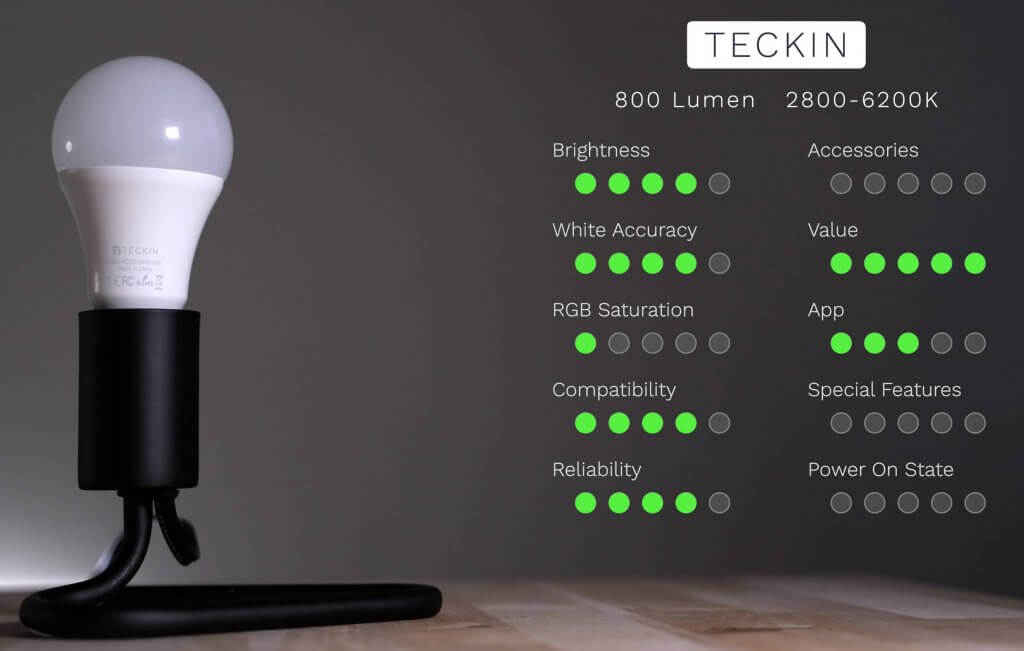
✓ Compatible with SmartThings or Home Assistant by integrating with the Smart Life app.
✓ Very inexpensive.
✓ Max brightness at both warm and cool whites.
✘ The RGB colors aren’t very bright.
✘ The white colors look okay but aren’t as accurate as WiZ. You may not care especially if it’s not in a room with another light.
✘ The minimum brightness doesn’t get very dim.
Wyze Bulb (white)
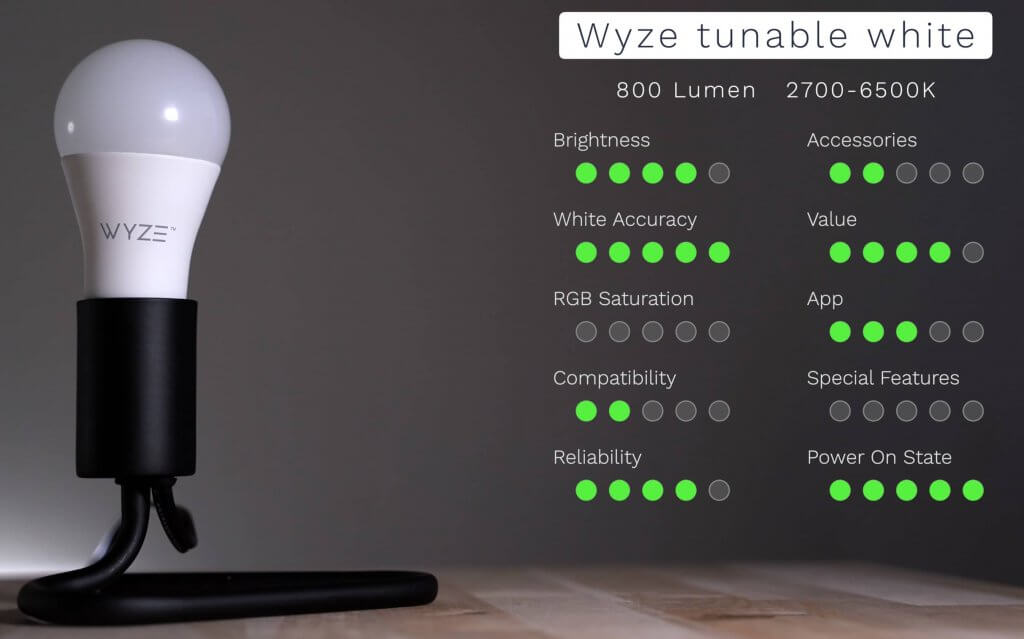
✓ Power On State.
✓ White colors are accurate.
✓ Integrates well with Wyze sensors and other Wyze devices.
✓ Max brightness on both warm and cool whites.
✘ No RGB in the current bulb but the new one is coming out soon with RGB.
✘ Only compatible with Alexa and Google Assistant. It’s not easy to connect these to platforms like SmartThings.
✘ The minimum brightness is not very dim.
TP-Link Kasa KL130 🏆
Winner: Best RGB WiFi Bulb for the Price
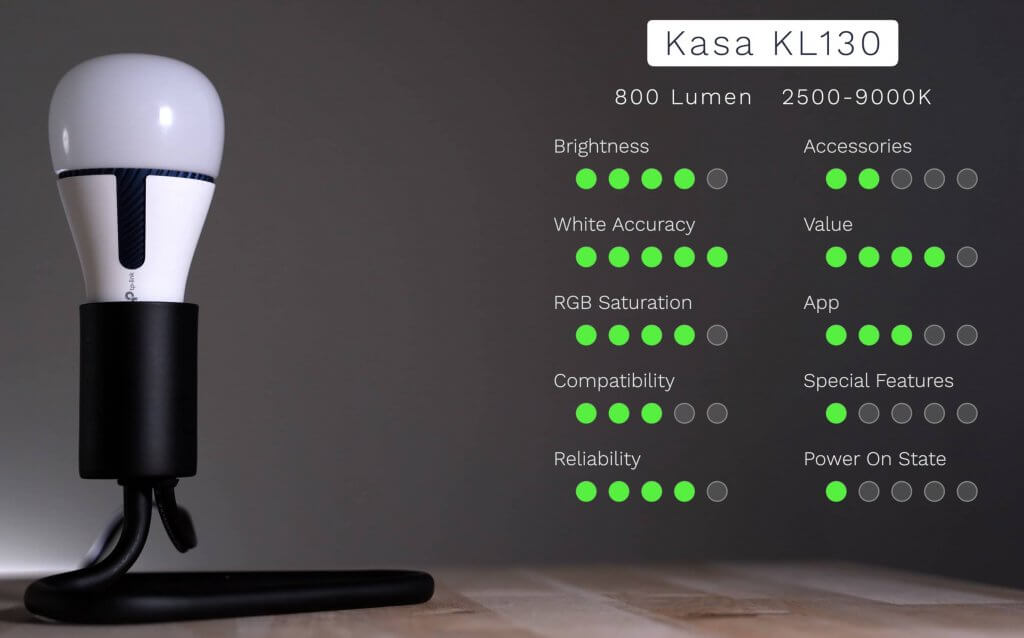
✓ Great RGB colors. Very saturated and bright.
✓ White colors are accurate.
✓ TP-Link or Kasa makes a lot of devices so you might already have their app.
✓ Works well with SmartThings.
✘ Missing extra functionality with the Power On State. However, you can choose what the bulb will be set to when powered on. You could set it to 1% brightness and it would help not wake up the family. However, the bulb will not stay powered off.
✘ The minimum brightness was slightly higher than others. The KL125 had a better minimum brightness.
TP-Link Kasa KL125
Very similar to the KL130. It’s slightly smaller in size and (at the time of making this) slightly less expensive. If they are about the same price, I would just go with the KL130 since it’s brighter, but I wouldn’t pay that much extra for it.
✓ Less expensive than the KL130.
✓ Better minimum brightness than KL130.
✘ Not as bright as the KL130.
Cree Connected Max A21 🏆
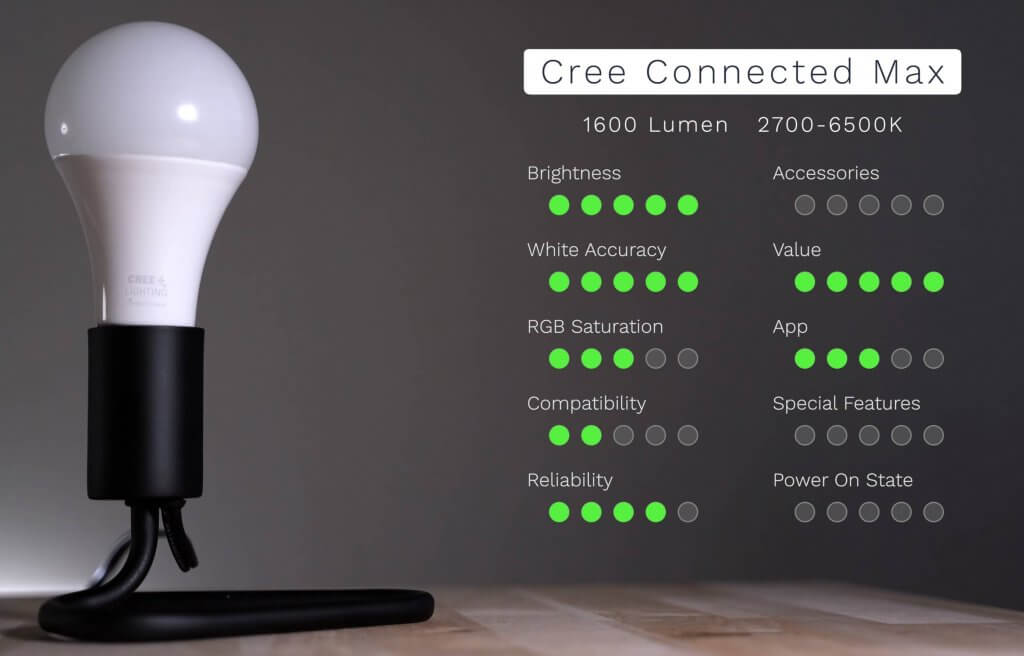
Winner: Best Brightness for the Price
✓ The white accuracy is amazing on this bulb. I didn’t give it enough credit in the video, but it was one of the best I tested.
✓ Very bright. Sure it’s a bigger bulb at A21, but the white colors are extremely bright. The warm whites were not as bright as the cool whites.
✘ One really weird thing is when dimming the bulb on a cool white it gets warmer as the brightness decreases. At 1% brightness it’s almost as warm as it gets. I tested this both on the Cree app and connected to Smart Life, and they both did the same. If the bulb is at full cool white and dimmed then it stays cool. I’m not sure if this is a bug or by design.
✘ The colors weren’t as bright as I would have liked.
✘ The minimum brightness was much higher than others.
Govee RGBWW
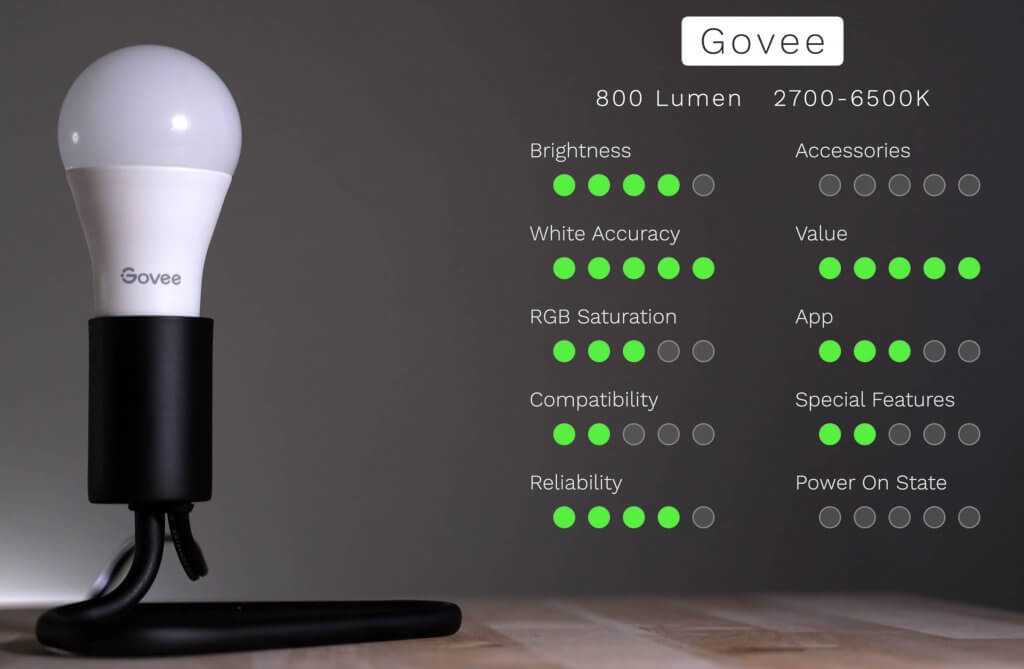
✓ The white colors look great. Very bright for both warm and cool whites.
✓ RGB colors are good.
✓ Govee always has a lot of scenes for their lights that are more advanced than just changing the colors.
✘ I couldn’t get the scenes to work with Alexa. If this was the case I could make the bulb blink a color if the doorbell was pressed very easily.
✘ Govee doesn’t work with many other platforms besides Alexa and Google Assistant.
✘ The minimum brightness was slightly higher than others.
— Other inexpensive WiFi bulbs not in the video —
Gosund
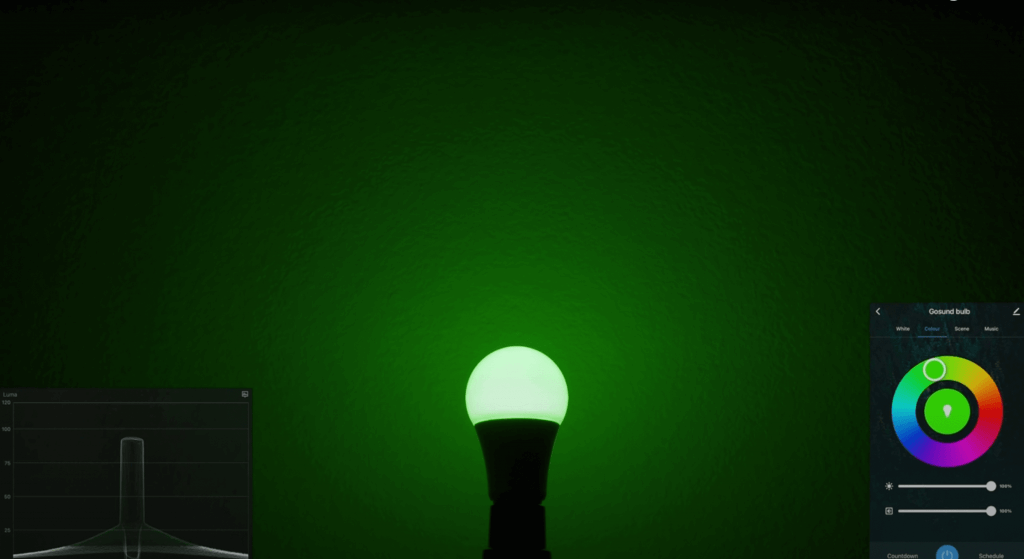
✓ Inexpensive
✓ Colors are okay.
✘ The white temperature can not be changed.
C by GE Tunable White Direct
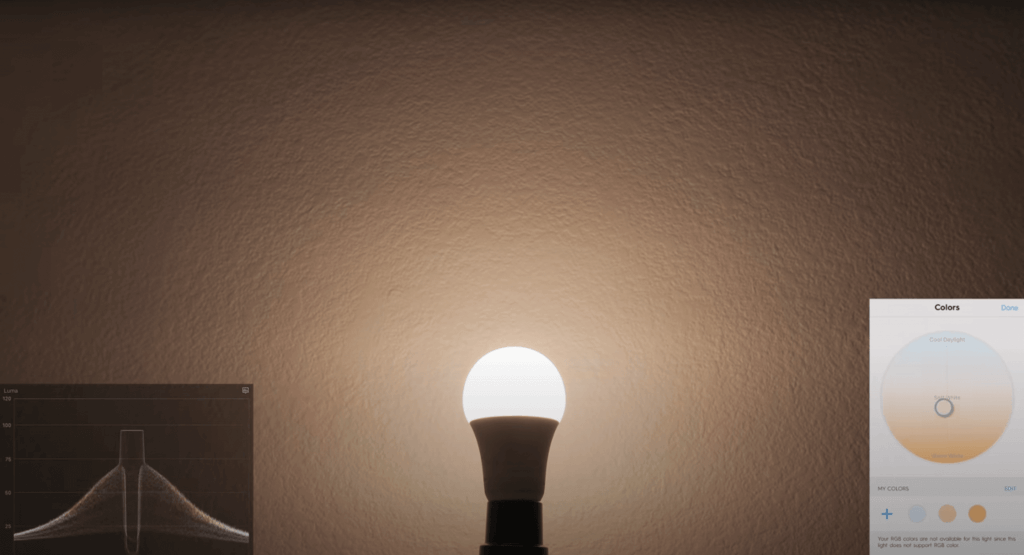
✓ Very bright
✓ White accuracy was good.
✓ Remotes and switches for the bulbs.
✘ The app was very difficult to use. C by GE is rebranding and creating a new app. I’m hoping their new app will be better. When the new app is ready, I will give them another shot.
✘ Not very compatible with other systems.
Legelite
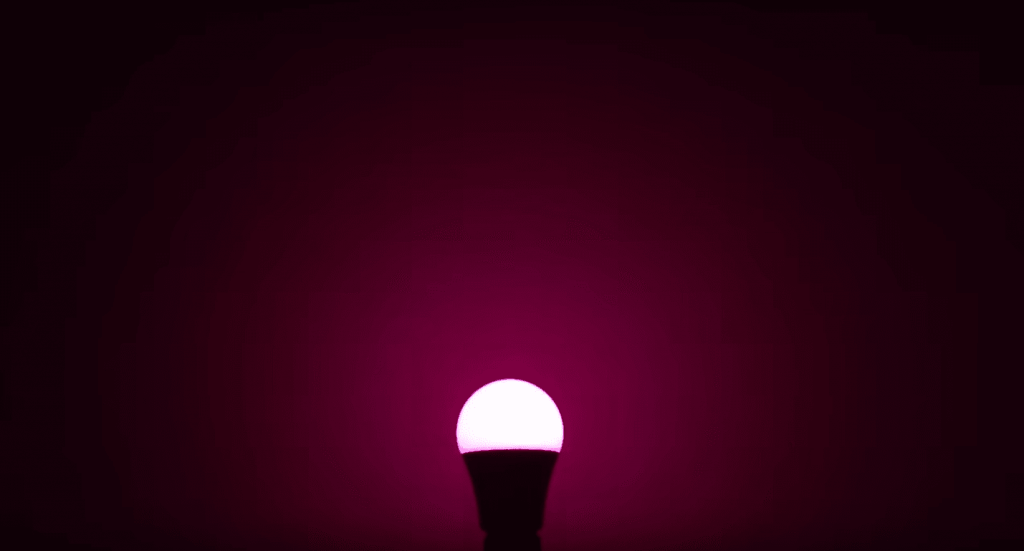
✓ Very inexpensive
✘ Not quite as good as TECKIN, which I like better since they both use Smart Life.
Novostella multicolor
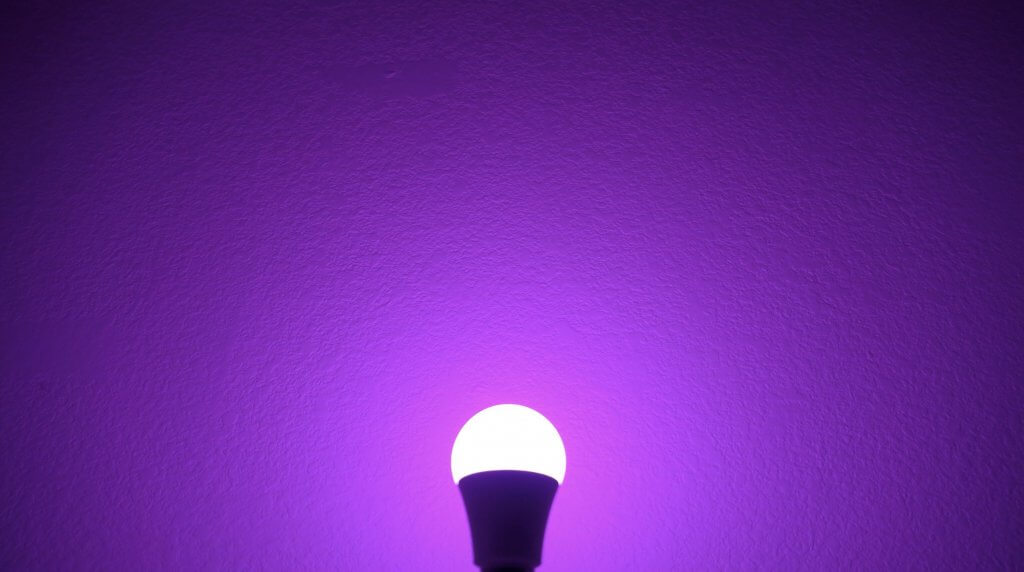
✓ Bright whites.
✓ Colors were good, but not great.
✘ They stopped selling the single bulb and you have to buy two. It’s in a weird place because Novostella’s 1300 lumen bulb is so much better. I would either pay more for a brighter bulb, or pay a little less for a competitor with around the same brightness.
Hub bulbs
Here are my ratings for hub bulbs. Please note that you can scroll the table horizontally to see more. →
| rated 1 to 5, 5 is best | Brightness or Kelvin | White accuracy | RGB Saturation | Compatible | Reliable | Accessories | Value | App | Special Features | Power On State | Overall Rating | |
|---|---|---|---|---|---|---|---|---|---|---|---|---|
| ilumin | 4 | 5 | 4 | 4 | 5 | 3 | 3 | 2 | 2 | 5 | 37 | ilumin |
| Sengled multicolor | 4 | 5 | 3 | 4 | 5 | 3 | 4 | 2 | 2 | 0 | 32 | Sengled multicolor |
| EcoSmart tunable white (Home Depot) | 4 | 5 | 0 | 4 | 5 | 3 | 7 | 2 | 0 | 0 | 30 | EcoSmart tunable white (Home Depot) |
| Nanoleaf Essential | 4 | 5 | 1 | 3 | 5 | 2 | 4 | 3 | 0 | 0 | 27 | Nanoleaf Essential |
| Sengled bright white | 5 | 5 | 0 | 4 | 5 | 3 | 4 | 2 | 0 | 0 | 28 | Sengled bright white |
| Gledopto | 4 | 4 | 3 | 4 | 5 | 3 | 3 | 2 | 2 | 0 | 30 | Gledopto |
ilumin by Inovelli 🏆
Winner: Best Hub Bulb Overall
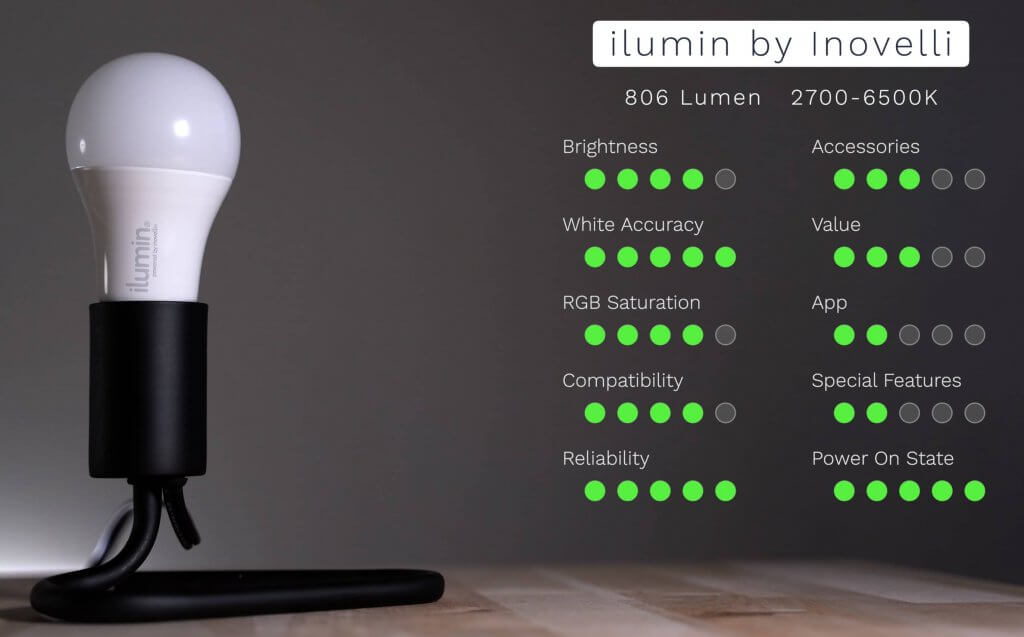
✓ Power On State. You have to add Inovelli’s device handler in SmartThings for this to work, but it only takes a minute to do.
✓ Great white and RGB colors.
✓ It can get very dim.
✓ Brightness was good.
✘ It’s a Z-wave bulb and if you have a Zigbee hub you can’t use it.
✘ Cool whites were not as bright as the warm whites.
Sengled multicolor 🏆
Winner: Best RGB Zigbee on a Budget
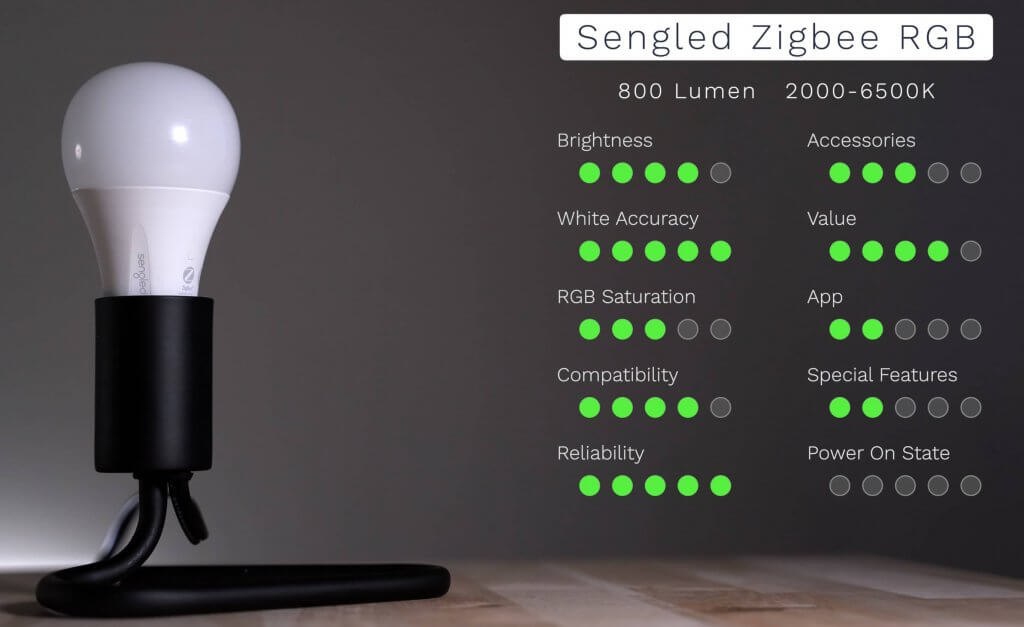
✓ Accurate white colors and priced well.
✓ Uses Zigbee so it’s highly compatible.
✓ Minimum brightness was acceptable but ilumin was much better.
✘ RGB colors are weak. They are about the same as Hue’s RGB colors in terms of brightness and saturation.
✘ Cool whites were not as bright as the warm whites.
Ecosmart tunable white 🏆
Winner: Best Inexpensive Zigbee Bulb
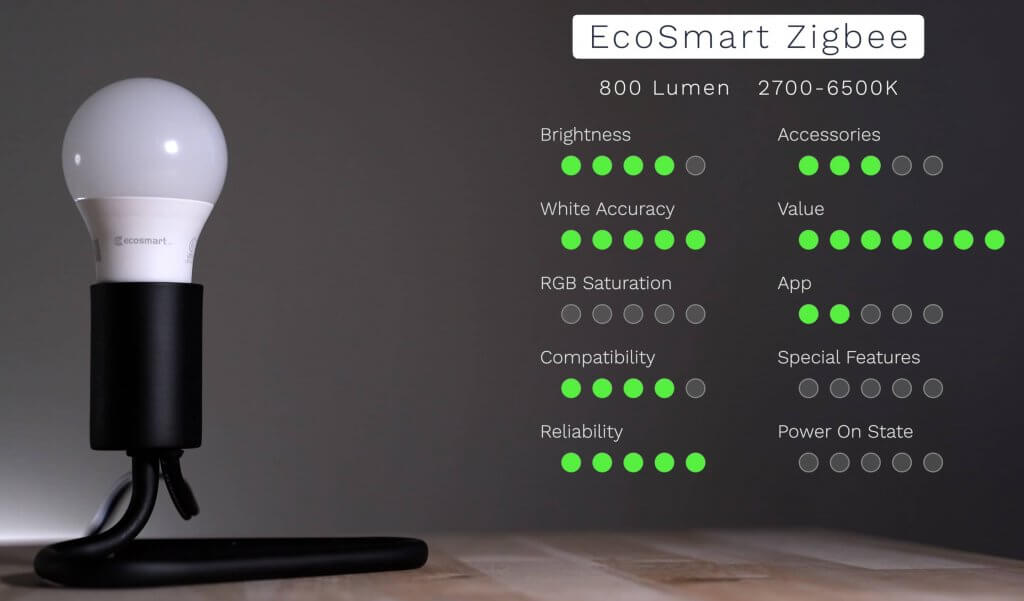
✓ $5 a bulb.
✓ White colors are some of the best I tested.
✓ Very bright on warm and cool whites.
✓ Works well with SmartThings, or the Echo 4th gen with a Zigbee hub.
✓ Minimum brightness gets very dim at 1%.
✘ It doesn’t have RGB.
EcoSmart also has WiFi bulbs that are very inexpensive as well. I haven’t tested them out myself but they seem to be really good if you want high quality inexpensive bulbs.
Nanoleaf Essentials
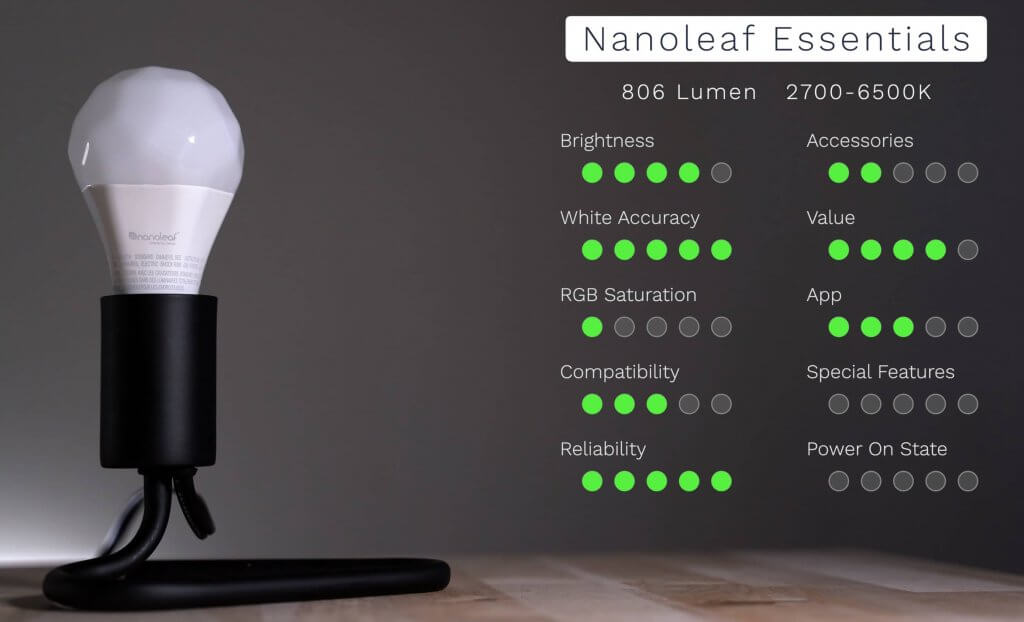
✓ White colors are bright and accurate. The warm whites were not as bright as the cool whites.
✓ Uses Thread so the connection is fast and reliable with HomeKit.
✓ Minimum brightness gets very dim at 1%.
✘ Colors are very dull and dim. I would only use the white colors on this bulb.
Sengled bright white
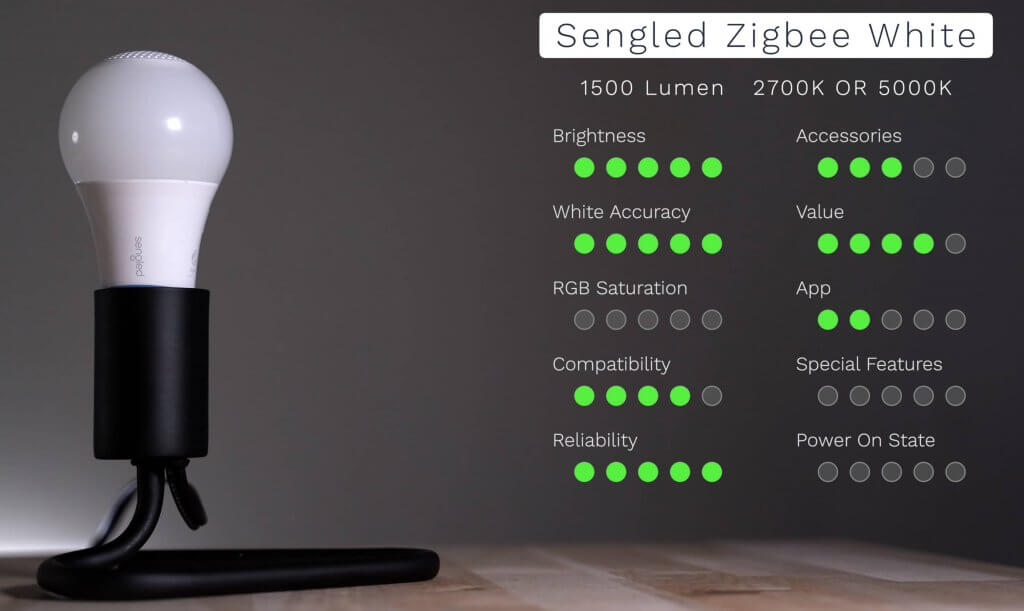
✓ Extremely bright. The brightest smart bulb I’ve ever tested.
✓ Uses Zigbee so it’s highly compatible.
✘ It can’t change white colors and it doesn’t have RGB colors.
✘ There is a vent on top so the bulb doesn’t overheat.
✘ The minimum brightness doesn’t get very dim at 1%.
— Other Hub bulbs not in the video —
Gledopto
✓ Great white colors and it was bright for both warm and cool whites.
✓ Uses Zigbee so it’s highly compatible.
✓ Minimum brightness gets very dim at 1%.
✘ The RGB colors were weak and not as bright as Sengled.
✘ The price was more than Sengled, so I didn’t include it in the video.
Ikea Tradfri 1000lm
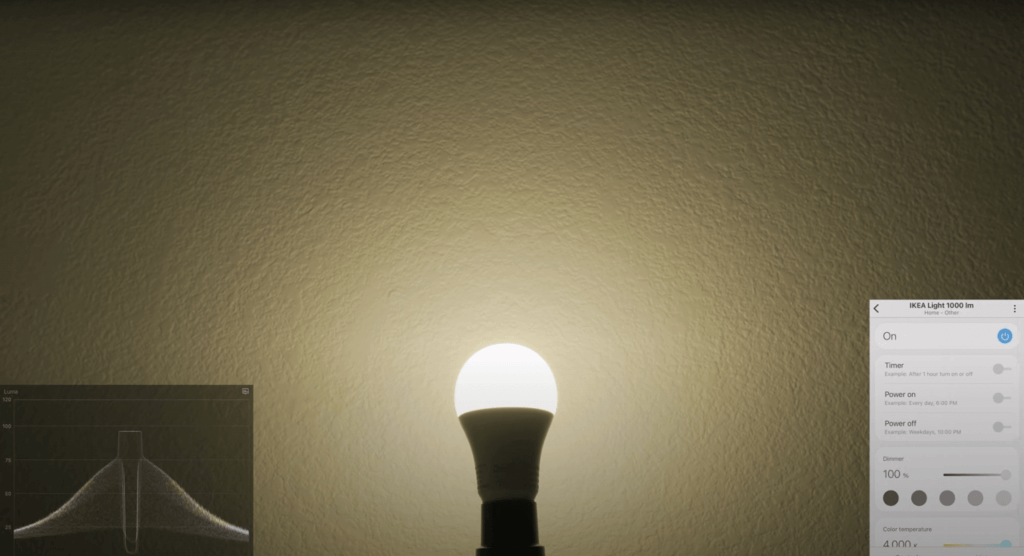
✓ Inexpensive and bright.
✓ It uses Zigbee and can connect directly with SmartThings.
✓ IKEA makes dimmer switches, buttons and motion sensors that work well with the IKEA bulbs.
✘ The white temperature caps out at 4000K. At that temperature, it is still warm and for not being able to do a daylight white, I personally wouldn’t get this bulb.
Ikea Tradfri 600lm
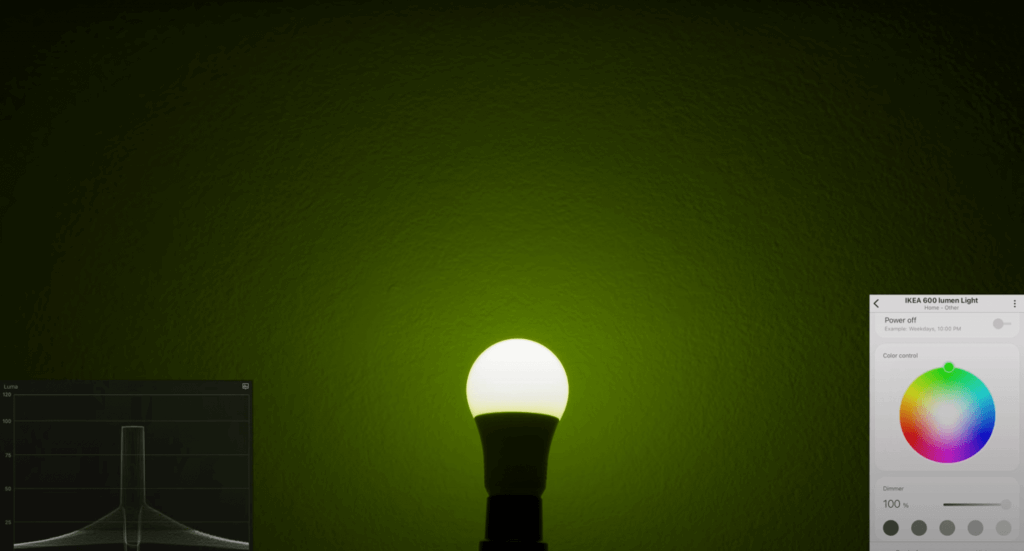
✓ The colors are bright.
✓ It uses Zigbee and can connect directly with SmartThings.
✓ IKEA makes dimmer switches, buttons and motion sensors that work well with the IKEA bulbs.
✘ There isn’t a white LED on this bulb, so the white color is simulated between RGB. It doesn’t look as good. That’s the reason I left this bulb out.
SmartThings bulb
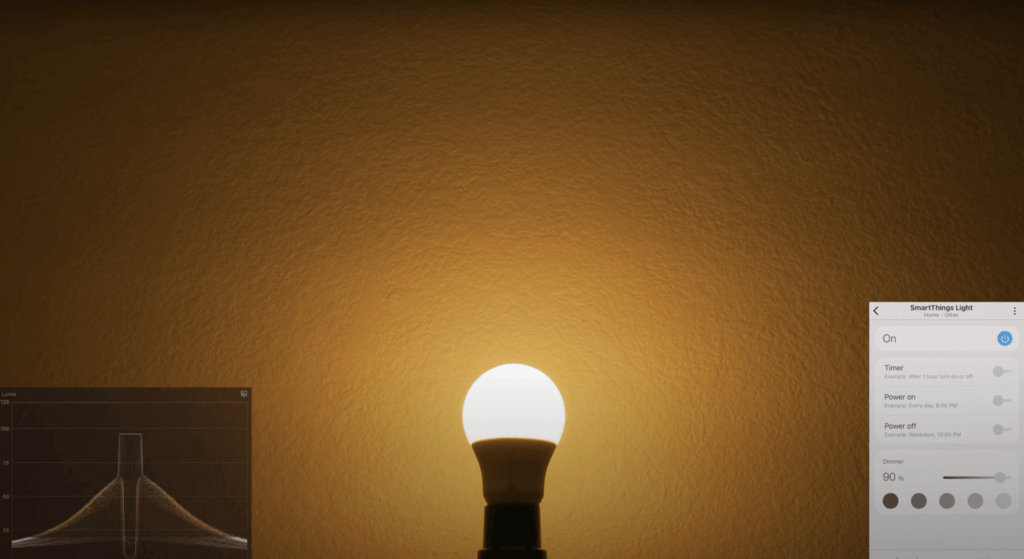
✓ Inexpensive for a Zigbee bulb.
✘ No RGB
✘ The white temperature can’t be changed. EcoSmart is a better Zigbee bulb for less money.
Sylvania Smart+ Zigbee
✓ Uses Zigbee
✘ This bulb was broken on arrival. Well, the plastic part on top was. Amazon could be to blame, but either way I wasn’t impressed.
✘ The brightness wasn’t good enough to even include in the video.
High End bulbs
Here are my ratings for high-end bulbs. Scroll the table to see more. →
| rated 1 to 5, 5 is best | Brightness or Kelvin | White accuracy | RGB Saturation | Compatible | Reliable | Accessories | Value | App | Special Features | Power On State | Overall Rating | |
|---|---|---|---|---|---|---|---|---|---|---|---|---|
| LIFX | 4 | 4 | 5 | 5 | 3 | 3 | 1 | 5 | 4 | 0 | 34 | LIFX |
| Philips Hue | 3 | 4 | 3 | 5 | 5 | 5 | 1 | 4 | 5 | 5 | 40 | Philips Hue |
| Yeelight | 4 | 3 | 5 | 5 | 3 | 0 | 3 | 3 | 2 | 5 | 33 | Yeelight |
| Novastella bright | 5 | 5 | 4 | 3 | 4 | 0 | 3 | 3 | 0 | 0 | 27 | Novastella bright |
| WiZ 100w A21 | 5 | 4 | 5 | 3 | 4 | 4 | 3 | 2 | 0 | 5 | 35 | WiZ 100w A21 |
Philips Hue 🏆
Winner: Best High End Bulb Overall

✓ The most reliable bulbs I’ve ever used. Because they have their own bridge, they keep everything running smoothly.
✓ The most accessories available. This is great for families, and their motion sensors are amazing. I’ve been using one for over 2 years and it’s still running strong on the two AAA batteries that came with it.
✓ Power On State.
✓ Hue Sync, which allows you to sync your Hue lights with your TV or computer monitor.
✓ Very compatible with other platforms. Hue has been around for so long and works with almost every smart home platform out there.
✓ Minimum brightness gets very dim at 1%.
✘ Expensive. Getting started with Hue isn’t cheap since you need to buy a bridge.
✘ They aren’t very bright and the colors are dull. This is why I originally had LIFX win in my first smart light bulb video. I wasn’t factoring everything with that decision though. Also warm whites are not as bright as cool whites.
✘ I’m not a fan of the white color picker in the Hue app. I would like to choose a Kelvin number.
LIFX 🏆
Winner: Best Bright Saturated Colors
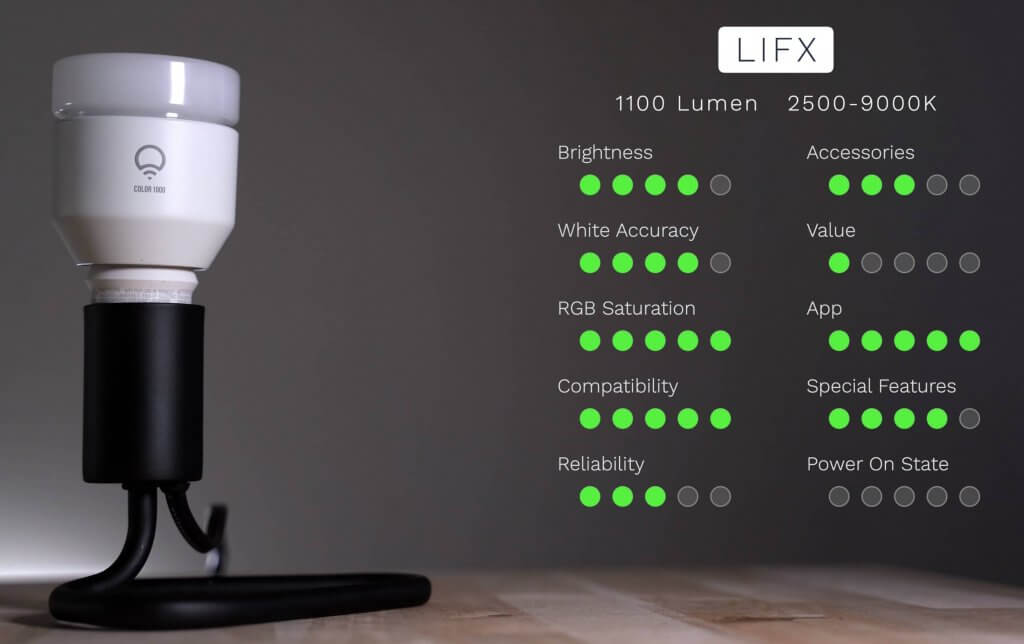
✓ The colors are so bright and vibrant that it puts every other smart light bulb to shame in this category.
✓ White colors are also bright. Also both cool and warm whites were bright.
✓ The app is my favorite smart light app. It’s not perfect but there are so many scenes that you can make and import into other platforms.
✓ Extremely compatible with other smart home platforms like Hue.
✓ LIFX does have their own light switch but it’s very pricey. Since they are compatible with so many other platforms, it’s not difficult finding other buttons and switches to control the LIFX lights.
✓ Minimum brightness gets very dim at 1%.
✘ They are missing Power On State. I only use these in my office now, and if they turn on in the middle of night it won’t wake anyone up. I’m not making that mistake again.
✘ They are expensive.
✘ I’ve had LIFX lights disconnect from my WiFi and this doesn’t happen with Zigbee lights.
Yeelight
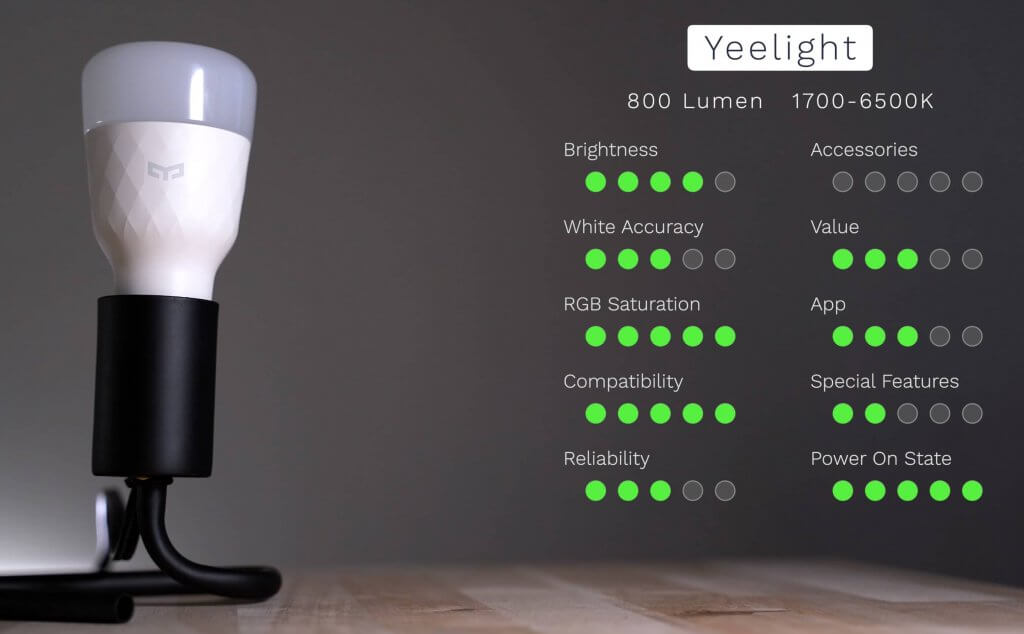
✓ Very saturated colors. Almost on par with LIFX.
✓ Power On State.
✓ Very compatible with other smart home platforms.
✓ About half the price of LIFX.
✘ White colors aren’t very accurate. Warm whites were also much more dim compared to cool whites.
✘ Similar to LIFX, these bulbs occasionally disconnect from WiFi and need to be turned off and on to re-connect.
✘ The minimum brightness was slightly higher than others.
Novostella bright white/multicolor
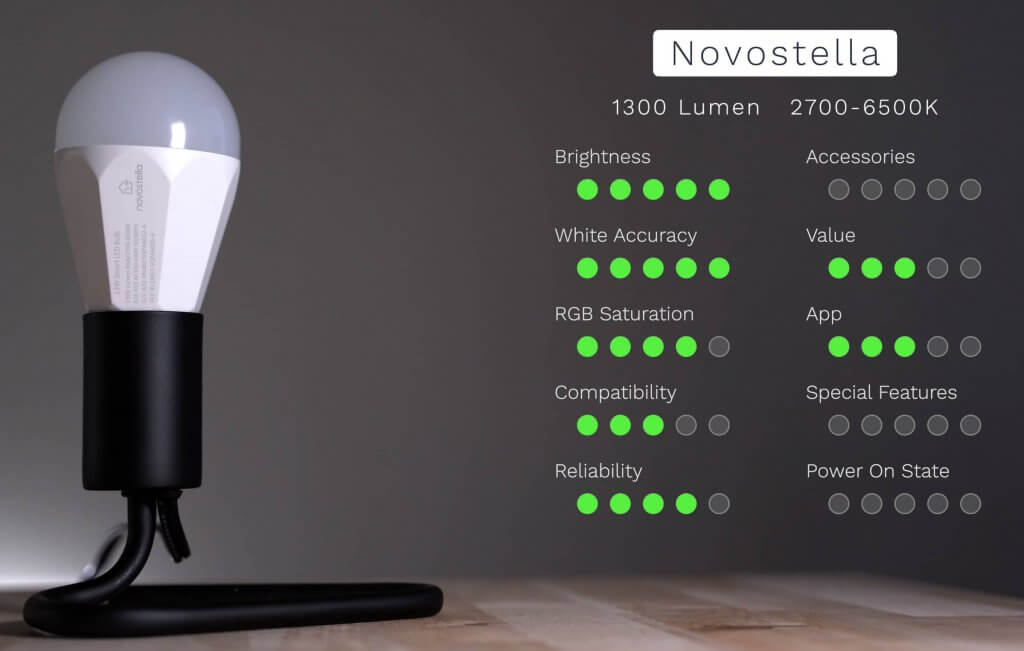
✓ It’s 1300 lumen so it’s bright. Sometimes bright smart lights aren’t bright with colors, but this bulb also has bright RGB colors as well.
✓ White accurate. Both warm and cool whites were bright.
✓ Inexpensive compared to LIFX.
✘ Missing Power On State, and it didn’t show up in SmartThings under the Smart Life integration.
✘ The minimum brightness was much higher than others.
WiZ 100w A21 🏆
Winner: Best White and RGB Brightness
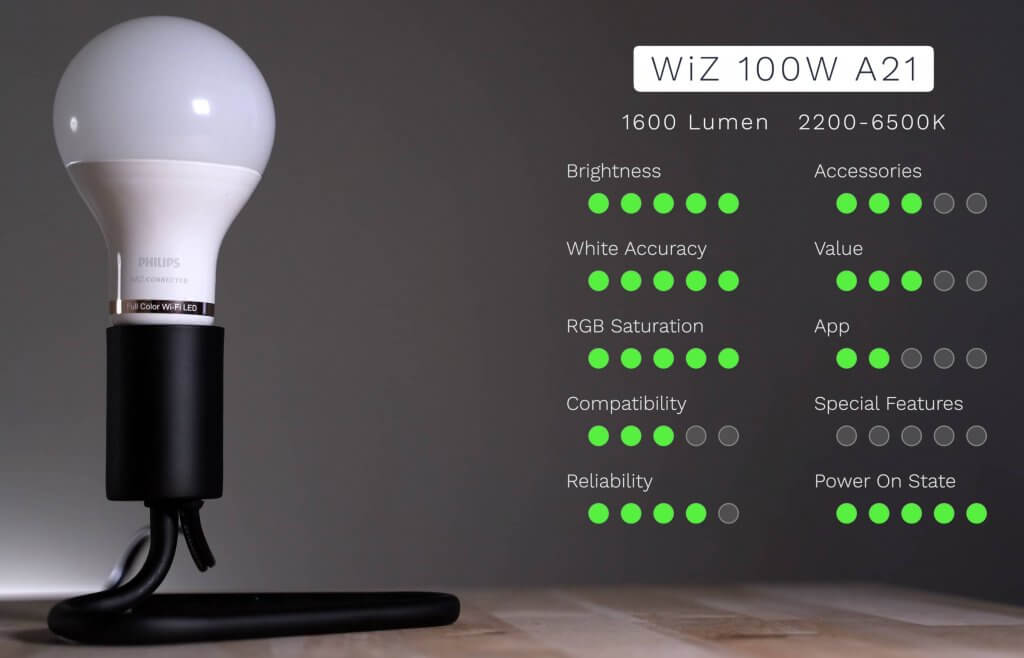
✓ Extremely bright bulb. Not only are whites bright, both warm and cool whites, but so are the colors.
✓ White accuracy was good, but I don’t know if it was as good as Cree’s when comparing A21 bulbs.
✓ Power On State, just like all the other WiZ bulbs.
✓ Works with SmartThings.
✓ WiZ remote and motion sensors are available, plus any switches that work with SmartThings.
✘ The A21 size might be too tall for your light fixture.
✘ The WiZ app needs some work. The home screen doesn’t show the names of the bulbs.
✘ The minimum brightness was much higher than others.
Filament bulbs
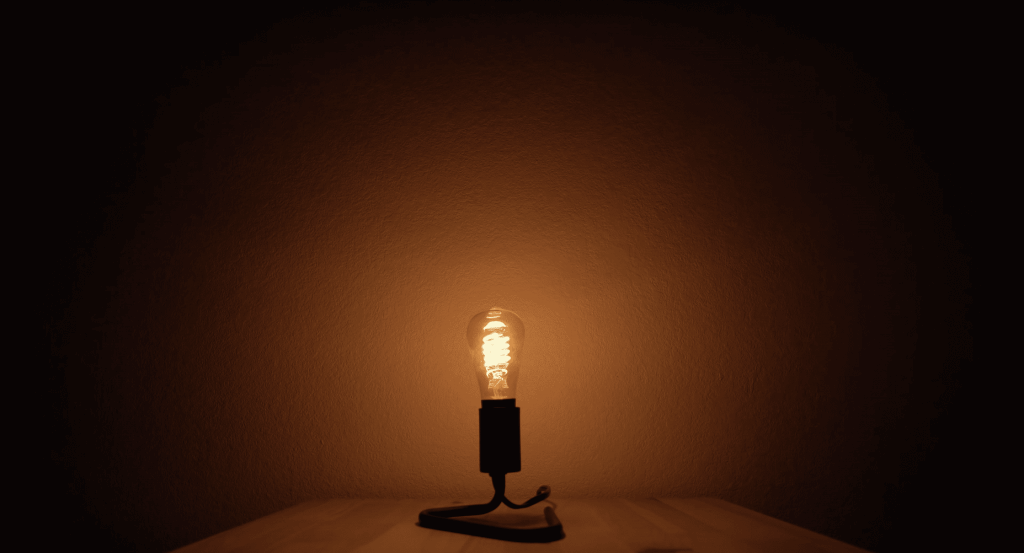
There are a few smart filament bulbs that look awesome and could be a fun addition to your set up. They all look and work similarly for the most part. Here are the links:
- Yeelight filament
- Kasa filament
- Philips Hue filament: nice spiral design. Looks great even when it’s dim.
- WiZ filament cool white / warm white: These bulbs are sold in 2 different versions for cool or warm white. We saw an updated filament bulb from WiZ at CES that allow you to change the warm and cool temperature on one bulb. It will be a separate bulb you can buy, but it’s not available in the USA yet.
If you made it this far… you’re amazing! Thank you so much for watching and reading how I rated these bulbs. If you liked this type of comparison, please make sure to subscribe to my YouTube channel for more.
I’ll also hang out in the comments of the video, so feel free to share your thoughts on your favorite smart bulb over there. Thanks!
Links to previous light bulb comparison videos: